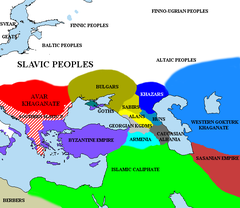Kubrat
| Kubrat | |
|---|---|
| King of Bulgaria | |
| Reign | 632–665 |
| Predecessor | Gostun |
| Successor | Batbayan |
| House | Dulo |
| Signature |  |
It has been suggested that Old Great Bulgaria be merged into this article. (Discuss) Proposed since September 2011. |
Kubrat or Kvrt (Bulgarian: Кубрат; Ukrainian: Кубрат; Chuvash: Купрат, Kuprat; Greek: Χουβράτης, Mari: Чумбылат, meaning "Wolf" in Old Turkic)[citation needed] was a Utigur Bulgar ruler credited with establishing the confederation of Old Great Bulgaria in 632. He is said to have achieved this by conquering the Avars and uniting their Kutrigurs who dominated the northern steppe with his ten Utigur Bulgar tribes under one rule. In his time the rule of the Bulgar Onoguri (ten tribes) occupied the lands between two major rivers; the Volga in the east, and Danube in the west.


The name Kubrat is first mentioned by Patriarch Nikephoros I of Constantinople, in his Short History in the 9th century. However the word first appears in the Orkhon inscriptions of the Gökturks and literally means "founding". According to the nomadic tradition almost every king was given a title which summarized his accomplishments or stressed a major one, such as Ilterish Khagan (İl "state", Terish "organizer", Khagan or Khan "king" ) for the king who united the Gökturks for a second time. The title for the founding king would be Kubrat Khagan, which would mean "The Founding King", which he was.
In the Nominalia of the Bulgarian khans Kubrat is mentioned as Kvrt of the Dulo clan. A later legend would describe him as a descendant of Attila the Hun. Some historians conclude that his maternal line was of the Ermy clan, because his maternal uncle Organa was possibly of that clan.[2] In Hungarian history, the Great Prince of the onogurs Árpád Almos, was from the Kubrat streaming, founding the Hungarian empire in Europe.[3]
Kubrat spent his time at the Byzantine court, either as a hostage or for protection from the dynastic war within the Hunic Khaganate. As the 6th-century Byzantine historian John of Nikiu narrates:
Quetrades (i.e. Kubrat), the prince of the Moutanes (i.e. Huns), and a nephew of Kuemaka (i.e. Organa), was baptized as a child and was educated in Constantinople and received into the Christian community in his childhood and had grown up in the imperial palace. He was a close friend of emperor Heraclius.[4]
Whether he was a child or an adult during his time in Constantinople is unclear, as the year of his birth is unknown. The exact time of this event is also unknown but probably coincided with the reign of Emperor Heraclius (r. 610–641). If the above text really applies to Kubrat then it becomes clear that during his stay in Constantinople he was educated and baptized. Probably at the same time he was given the title patrikios, which was inscribed on his ring.
Upon his return, Kubrat took power over his tribe, the Utigur Bulgars, from Organa, who had acted as regent until then. At some point, as Patriarch Nikephoros records, Kubrat overthrew the Kutrigur's Avar hegemony and ruled alone over the united Bulgars, thus creating "Great Bulgaria" of Onoguri, as it was known to its contemporaries. Under his rule, Old Great Bulgaria grew to stretch from the Danube (under generals Altsek and Kuber) in the west to the Volga river (under general Kotrag) in the east, and was recognized by a treaty signed with Byzantium in 635. Kubrat ruled in peace with the Byzantine Empire, a result of his close friendship with the Byzantine emperor and, conceivably, of his appreciation of Byzantine culture.
According to legend the 3rd (Asparukh), 4th (Kuber), and 5th (Altsek) of the many generals (styled "sons") of Kubrat with their hordes originally inhabited the Avar Khaganate. Altsek's Bulgars were isolated from the Bulgar Onoguri during Kubrat's lifetime. After Kubrat's death, the Kazarig general subjugated Kubrat's son Batbayan[5] forcing the Utigur hordes to move the Onoguri capital to Pannonia officially in 677,[6] but were ousted again by the Kazarig's new "Avar" allies in the 680s.[7]
The Pereshchepina hoard was discovered in 1912 by Ukrainian peasants in the vicinity of Poltava, yielding, gold and silver objects of total weight of 75 kg, including a ring which eventually allowed identification of the grave as that belonging to Khan Kubrat. The ring was inscribed in Greek "Chouvr(á)tou patr(i)k(íou)", indicating the dignity of patrikios that he had achieved in the Byzantine world.
Kubrat Knoll on Livingston Island in the South Shetland Islands, Antarctica is named after Kubrat of Great Bulgaria.
Kubrat was portrayed by Vassil Mihajlov in the 1981 Bulgarian movie Aszparuh, directed by Ludmil Staikov.
See also
References
- ^ Nicephori Archiepiscopi Constantinopolitani Opuscula Historica, editor Carl G. de Boor, 24, 9-12.
- ^ Vasil Zlatarski, History of Bulgaria
- ^ The Thirteenth Tribe: The Khazar Empire and its Heritage;Koestler, Arthur
- ^ John of Nikiû, Chronicle
- ^ "680: Battle of Ongal". Homeshop18.com. Retrieved 2014-04-10.
- ^ Chronicon Pictum
- ^ Miracles of Saint Demetrius
